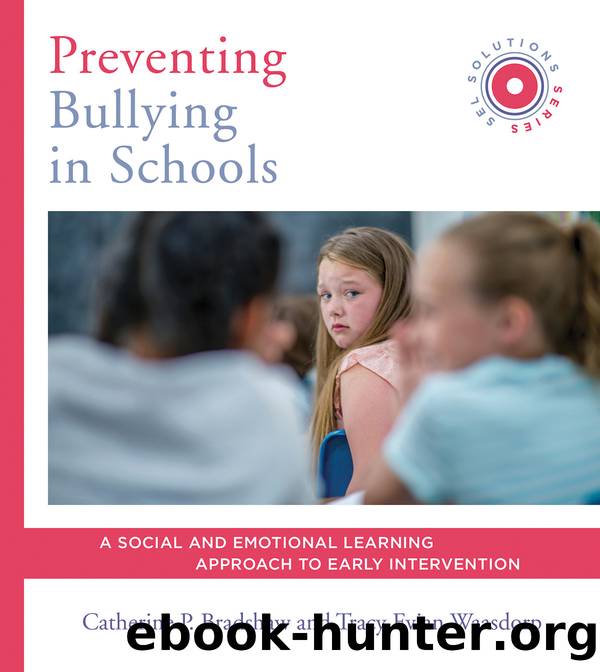Preventing Bullying in Schools by Catherine P. Bradshaw

Author:Catherine P. Bradshaw [Catherine P. Bradshaw and Tracy Evian Waasdorp]
Language: eng
Format: epub
Tags: Epub3
ISBN: 9780393713725
Publisher: W. W. Norton & Company
Published: 2019-08-28T00:00:00+00:00
Model Empathy
Strategies to model positive ways to interact with others and to cope with difficult social situations are a crucial piece of an SEL approach to bullying prevention. To model empathy for your students, start by labeling how you feel for the class. Label your emotions (e.g., frustration, anger, sadness) and your students’ emotions. When you witness bullying, try to reflect what you see by labeling the students’ emotions (e.g., face and body responses): “I see clenched fists and rapid breathing. It looks like you are so angry.”
Use “I statements” to model assertive communication skills: “I’m upset to hear what you just said to her. Teasing is never okay. Our class has a rule to use only positive words about others.” You can also use such a situation as an opportunity to remind the class of the group’s expectations. Adults working with children and adolescents should avoid using sarcasm. Some students may be particularly sensitive to sarcasm, and feel embarrassed by it. For example, if a child says to you, “I promise I will bring my homework in tomorrow,” and you reply with sarcasm by saying “Yeah, I have heard that before,” this signals your distrust of the student. Also, avoid making jokes or comments about a child’s “quirky” behavior or physical appearance. While the intent might be humor, children will likely not view it that way—particularly those who are anxious and high in rejection sensitivity. Such behaviors are likely interpreted as teasing, setting a precedent that teasing is acceptable in the classroom. Similarly, when stressed, teachers can be short or curt with certain students, may point out a child’s error in front of the class, or yell at a student. It is important to keep in mind how powerful and influential your behaviors are; modeling empathy and effective emotional regulation for others should be a priority. These might be critical times to use a “mindful moment” to become more aware of how your own stress and behavior may be negatively perceived by students.
Download
This site does not store any files on its server. We only index and link to content provided by other sites. Please contact the content providers to delete copyright contents if any and email us, we'll remove relevant links or contents immediately.
The Art of Coaching Workbook by Elena Aguilar(50990)
Trainspotting by Irvine Welsh(21520)
Twilight of the Idols With the Antichrist and Ecce Homo by Friedrich Nietzsche(18505)
Fangirl by Rainbow Rowell(9098)
Periodization Training for Sports by Tudor Bompa(8171)
Change Your Questions, Change Your Life by Marilee Adams(7637)
This Is How You Lose Her by Junot Diaz(6796)
Asking the Right Questions: A Guide to Critical Thinking by M. Neil Browne & Stuart M. Keeley(5649)
Grit by Angela Duckworth(5525)
Red Sparrow by Jason Matthews(5391)
Paper Towns by Green John(5092)
Room 212 by Kate Stewart(5040)
Ken Follett - World without end by Ken Follett(4646)
Housekeeping by Marilynne Robinson(4349)
The Sports Rules Book by Human Kinetics(4297)
Double Down (Diary of a Wimpy Kid Book 11) by Jeff Kinney(4208)
Papillon (English) by Henri Charrière(4199)
The Motorcycle Diaries by Ernesto Che Guevara(4016)
Exercise Technique Manual for Resistance Training by National Strength & Conditioning Association(3957)
